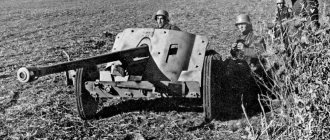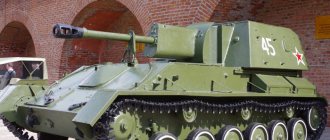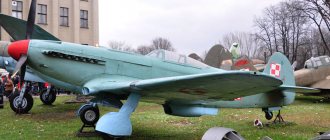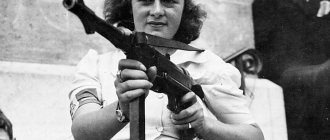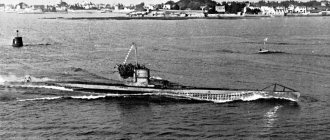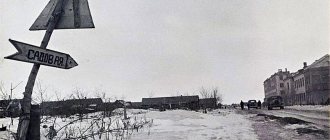Capsule bushings
German ammunition used primers and electric bushings. The external difference is that capsule ones have a blind bottom cut, while electric ones have a hole in the center of the bottom cut into which the contact rod is placed. The stamps on the bushings are placed on the bottom surface of their body. The stamps indicate the bushing index, what material it is made of, the company, batch number and year of manufacture. For example, the stamp “ C/22 St.” bmq 133 42
"indicate:
C/22 - bushing index; St. — the material from which the bushing body is made, in this case steel; bmq - company;
133 - batch; 42 - year of manufacture. All steel bushings are marked with the abbreviation “
St.
"(Stahl).
On formatted steel capsule or tin-plated electric ones, white markings are often placed instead of stamps. Stamps or white markings on the tracers were applied on the protruding part. They are often placed on the surface of key recesses. The stamps indicate the company, batch number and year of manufacture. For example, the brand “ Rdf 171 42
” means:
Rdf - company; 171 - batch; 43 - year of manufacture.
Read more about the coloring of German shells and mines
Stamps on the detonator
stamps on the bottom of the detonator
On detonators, stamps were placed on the bottom of the aluminum shell.
Three-letter code of the manufacturer and designation of the explosive with which the detonator is equipped. For example, " Np.
10 "(nitropenta 10%) means that the detonator is equipped with PETN, phlegmatized with 10% mountain wax (ozokerite). In addition to the standard and general stamps and markings shown, on some parts of the projectiles, most often on the cylindrical part of the body, there are additional special stamps that have a special meaning
Painting of German shells and mines
Painting Painting of shells and mines has two purposes, protecting the shell of the projectile from corrosion and providing easily perceptible information about the type, purpose and effect of the ammunition. Fuses with a plastic body and an iron shell are painted to protect the glasses from corrosion, and are also painted to protect them from corrosion.
Coloring of German mines, shells and fuses:
The following are painted in a dark green protective color: a)
all main and special-purpose ground artillery shells, except for all armor-piercing and propaganda shells and two types of 37-mm fragmentation tracer grenades intended only for ground fire.
b)
all mines with a steel shell
; c)
fuses with a plastic body covered with a thin iron shell.
All armor-piercing shells, of all calibers, systems and devices,
are painted black are painted yellow
, except for 37-mm fragmentation tracer grenades intended for ground firing from anti-aircraft guns;
such shells are painted in a dark green protective color. The following are painted red: a)
all mines with a shell made of steel or malleable cast iron;
b)
Propaganda shells, the head of which is painted white.
Explosive projectiles
Explosive projectile
The next stage in the development of ammunition was explosive projectiles. Cast iron or iron cannonballs, empty inside, were filled with gunpowder. At the moment of detonation, the grenade split into many fragments. Metal pieces were scattered tens of meters away. Such nuclei had a significant drawback: approximately a quarter of the described ammunition did not explode. Another part worked ahead of time and hit their own soldiers.
Standard markings of German shells and special distinctive features
Standard markings include conventional combinations of letters and numbers found on the elements of a shot in order to determine all the necessary data on them or on the shot as a whole for their official operation. Standard markings are available on shells and mines, on the cartridge cases of cartridge-loading shots and the caps of their combat charges, and on the caps of variable combat charge bundles. Often this marking is duplicated by labels attached to the cap of the variable charge and on the closure of the ammunition, regardless of their design. The markings are applied in white, black or red paint. On all shells, with the exception of armor-piercing shells of all calibers, painted black, and 20mm fragmentation and armor-piercing incendiary-tracer shells, markings are applied with black paint and only on the cylindrical part and head. Armor-piercing shells of all calibers have similar markings, but are red. 20mm fragmentation-incendiary-tracer and 20mm armor-piercing incendiary-tracer shells, like all shells of this caliber, are marked only on the cylindrical part, the former being red and the latter being white, which serves as an additional distinctive feature of incendiary shells of this caliber. In addition to the standard black markings on the cylindrical part and head, shells of separate cartridge-loading shots have additional white markings on the bottom section. The weight category, or ballistic mark, is placed in the form of a Roman numeral on the cylindrical part of the projectile on both sides and only on projectiles of 75mm caliber and above.
Meaning of ballistic signs:
I - Lighter than normal by 3-5% II - Lighter than normal by 1-3% III - Normal +- 1% IV - Heavier than normal by 1-3% V - Heavier than normal by 3-5%
On armor-piercing tracer sub-caliber projectiles with tungsten carbide core does not have standard markings. The standard markings on mines are painted black, and their meaning is completely similar to the meaning of the markings on shells. The standard markings on cartridge-loading shot casings are applied with black paint on their body. The same markings are applied to the caps or semi-caps of the combat charge of these shots. The standard markings on the caps of variable-combat charge bundles differ from the markings on the caps of the combat charge of cartridge-loading rounds only in that the former additionally have an indication of the bundle number. Standard markings on closures with cartridge-loading rounds indicate only their number, caliber of shells and the purpose of the latter, and on closures with combat charges of separate cartridge-loading rounds only their purpose. See labels for more details. Special distinguishing features are very diverse. they play an important role and are applied to various elements of shots in the form of colored stripes, letters or numbers to indicate the characteristics of the equipment, design or use of ammunition. The location of their application and conventional meanings are shown in the figure “Special distinctive features”
Large caliber to help infantry
By the beginning of World War II, in many armies of the world, mortars had firmly taken the place of the main means of supporting infantry at the company and battalion level. As for the regimental level, infantry guns were used quite widely. In most cases, the military preferred to make do with one model - for example, in the Red Army it became the 76-mm regimental gun of the 1927 model. The German military decided that this was not enough, and two types of guns began to be supplied to the Wehrmacht infantry regiments - the quite ordinary 75-mm leIG 18 cannon and the 150-mm sIG 33 gun, which had no analogues in any other army.
The positional nature of the fighting of the First World War led to the emergence of a whole class of infantry (trench) artillery, represented by various guns and mortars. In the Kaiser's army, heavy and medium mortars of 250 and 170 mm calibers were initially used for these purposes, but soon lighter 76 mm mortars appeared - in September 1916, there were already 1345 such systems in the German army. A common drawback of all mortars was their low mobility - they were more suitable for defense than for attack. At the same time, the task of destroying machine gun nests - this “scourge of God” for the infantry - was much more urgent during offensive operations. By 1918, several models of light infantry guns had been developed in Germany, but none of them had time to be put into service.
According to the Treaty of Versailles, the German army was prohibited from having infantry guns in service - only mortars remained in the units. Each Reichswehr infantry regiment received a mortar company consisting of three platoons of light mortars (a total of six 7.6 cm leichte Minenwerfer neuer Art - new-style light mortars) and one medium (two 17 cm Mittlere Minenwerfer neuer Art - new-style medium mortars) . On the other hand, the Treaty of Versailles allowed the preservation of six weapons design bureaus (including those of the Krupp and Rheinmetall concerns), which made it possible to continue the development of promising models of infantry guns.
On the pages of the specialized press in the Weimar Republic, tactical issues of using such systems and technical requirements for them were actively discussed. At first, the idea of a universal weapon capable of hitting both mobile armored targets and stationary shelters seemed very attractive. But the anti-tank role required a high initial velocity of the projectile, and, consequently, a rather long barrel, which made it difficult to conduct overhead fire. In the end, the Germans decided to go down the path of specialization, creating anti-tank and infantry guns instead of universal systems.
In 1927, the Reichswehr adopted the 7.5 cm leichte Infanteriegeschütz 18 (leIG18) light infantry gun. At the same time, the design bureau of the Rheinmetall concern developed a heavy 150-mm infantry gun - for several years this system could not win the trust of the military, who considered it too heavy for the regimental level. The system could have sunk into oblivion if not for the Soviet order - on August 28, 1930, an agreement was concluded with (the front office of the Rheinmetall concern) for the supply of eight 150-mm mortars (as these guns were classified in the USSR), converted to 152 caliber .4 mm, and assistance in establishing licensed production. The gun was adopted by the Red Army under the designation “152-mm mortar mod. 1931", in documents it often appeared as "NM" ("German mortar"). In 1932–1935, the Putilov plant produced a small batch of these guns; in total, the Red Army had 105 NM units (including those supplied from Germany). It is interesting that, in accordance with the artillery armament system of the Red Army, the 152-mm mortar belonged not to regimental, but to divisional artillery.
The recognition received by the heavy infantry gun abroad prompted the German military-political leadership to adopt it for service. In 1933, the 15 cm schweres Infanteriegeschütz 33 (sIG 33) - a 15 cm heavy infantry gun of the 1933 model - appeared in service with the Reichswehr.
Design
The sIG 33 gun had a very conservative design. The barrel with a caliber of 149.1 mm and a length of 1700 mm (11.4 calibers) consisted of a monoblock pipe and a breech mounted on the breech of the pipe and reinforced with a connecting nut. The gun had no muzzle brake, and the bolt was a horizontal wedge. The number of grooves is 44, the slope (constant) is 22.4 calibers.
Using two grips, the barrel was connected to a trough-type cradle, which housed fixed recoil devices: on the left – a spindle-type hydraulic recoil brake; on the right is a hydropneumatic knurl, consisting of two cylinders located one above the other in a common cage. The balancing mechanism is a spring, push type, located on the sides in the form of two columns. The lifting mechanism is sector type. When aimed horizontally, the frontal part of the machine slid along the combat axis. The gun was equipped with a ZE34 sight.
sIG 33 gun on a horse-drawn carriage Source: guns.ru
The gun had a rather massive two-wheeled carriage (box-shaped, single-bar). To ensure maximum vertical aiming angles, the shield (same as in the leIG18 light infantry gun) was attached in front of the wheels. The maximum elevation angle was 75º – that is, the gun was a full-fledged mortar. The range of horizontal aiming angles, despite the simple single-beam carriage, was also quite large - 11.5º to the right and left.
sIG 33 gun on a carriage for mechanical traction Source: guns.ru
The carriage wheels are cast aluminum with iron tires and rubber tires (for mechanical traction) or without them (for horse traction). The carriage had a torsion bar suspension, which made it possible to tow the gun at a speed of 35–40 km/h. In the stowed position in the mechanized version, the gun weighed 1825 kg, in the horse-drawn version - 1700 kg. Naturally, for maneuvering on the battlefield it was desirable to lighten the artillery system, so at the end of the 30s the Germans tried to replace the steel in the carriage design with light alloys, and the weight of the gun was reduced by one and a half centners. However, before the outbreak of World War II, they managed to produce very few lightweight carriages, and then, due to a shortage of light metals, they returned to steel ones. The crew of sIG 33 consisted of seven people.
Gun sIG 33 Source: the-blueprints.com
Ammunition
The sIG 33 gun had ammunition consisting of separately loaded rounds. It included the following types of projectiles:
- 15 cm IGr33 and 15 cm IGr38 - standard high-explosive fragmentation shells weighing 38 kg, filled with amatol (explosive mass - 8.3 kg);
- 15 cm IGr38 Nb – smoke projectile weighing 40 kg. The projectile created a smoke cloud with a diameter of about 50 m, the average smoke time was 40 s;
- 15 cm IGr38 Br – incendiary projectile weighing 39.7 kg;
- 15 cm IGr39 HL/A - a cumulative projectile weighing 24.6 kg, filled with hexogen (explosive mass - 4.14 kg). Armor penetration – 160 mm at a range of 100 m, maximum (tabular) firing range – 1200 m;
- 15 cm Stielgranate 42 is an over-caliber projectile with a three-fin stabilizer, designed to destroy field fortifications and make passages in wire and minefields. The mass of the projectile is 89.5 kg, the mass of the explosive (amatol) is 54 kg. For comparison, the F-364 mine of the Soviet 240-mm Tulip mortar contains 31.9 kg of explosive, while, unlike the mortar, the sIG 33 gun could fire direct fire at pillboxes, houses and other targets. To fire an over-caliber projectile, special charges with a gunpowder weight of 760–880 g were used. The initial velocity of the projectile was 105 m/s, the maximum firing range was about 1000 m.
1/2
Heading1
Heading2
Preparing the sIG 33 ammunition. The photo shows high-explosive fragmentation shells and stacked short cartridges with charges. 5th SS Panzer Division "Wiking", Eastern Front Source: waralbum.ru
sIG 33 gun with Stielgranate 42 over-caliber projectile Source: reibert.info
The shells had brass or steel sleeves with a length of 113.1 mm, and the flange diameter was 170.2 mm. The charge consisted of a main package and six weighted bundles of diglycol or nitroglycerin powder. When firing 15 cm IGr33 and 15 cm IGr38 projectiles on the 1st (minimum) charge, the initial speed was 125 m/s, the maximum firing range was 1475 m, on the 6th (maximum) charge – 240 m/s and 4700 m, respectively.
In service with the Wehrmacht
Serial production of the sIG 33 began in 1933 at . The gun turned out to be quite expensive - it cost 20,450 Reichsmarks. The light infantry gun leIG18 cost three times less (6,700 Reichsmarks), even the divisional 105-mm howitzer leFH18, much more complex in design, cost less - 16,400 Reichsmarks.
By September 1939, the Wehrmacht received over 400 heavy infantry guns. After the outbreak of World War II, the AEG concern's enterprise in Berlin-Hennigsdorf and (formerly Ceska Zbrojovka) in Strakonice was involved in their production. In total, 4155 sIG 33 were produced during the war years (including 48 in September-December 1939, 310 in 1940, 492 in 1941, 420 in 1942, 862 in 1943, 1613 in 1944, 410 – in 1945).
By the beginning of World War II, the Wehrmacht had 410 heavy infantry guns - such a modest number was not enough for all divisions. Initially, sIG 33 received 35 infantry divisions of the 1st wave of mobilization and 16 divisions of the 2nd. The divisions of subsequent waves had only light infantry guns; the 33 tank, light, motorized and mountain divisions did not have sIG guns at all.
In the divisions of the 1st and 2nd waves, each infantry regiment had a separate (13th by number) company of infantry guns, which had six leIG18 and two sIG 33. In total, the infantry division had 18 light and 6 heavy infantry guns.
A company of infantry guns from one of the Wehrmacht regiments. In the foreground, the crew is moving the leIG18 light gun. In the background is the sIG 33 - you can't roll it by hand... Source: thefewgoodmen.com
A company of infantry guns consisted of a control platoon, three platoons of light infantry guns and one of heavy ones. According to the staff, there were about 180 personnel and 133 horses. The company did not have any mechanical means: officers and non-commissioned officers moved on horseback, the rest of the personnel - on the limbers of guns and charging boxes.
The platoon of heavy infantry guns had the following organization:
- command – platoon commander and deputy platoon commander;
- control department - two fire non-commissioned officers, a rangefinder, two messengers, three telephone operators and a horse handler;
- two gun crews, each with a gun with a limber and a six-horse team, a gun commander, a gunner, two loaders, three carriers, three riders;
- ammunition supply train - two charging boxes with limbers and two carts with four-horse teams.
The regiment commander used his “own” artillery to hit targets that were inaccessible to machine guns and mortars. Thanks to the presence of a company of infantry guns, the regiment could effectively destroy field fortifications, machine gun nests and similar targets. Platoons of light infantry guns could be assigned to battalions, while heavy ones were always used centrally.
1/3
Heading1
Heading2
Heading3
SIG 33 gun in the Ukrainian steppe Source: thefewgoodmen.com
One of the most famous photographs dedicated to the Battle of Kursk - a German prisoner of war sitting on the carriage of a broken sIG 33 gun Source: waralbum.ru
Soviet soldiers inspect captured sIG 33 guns Source: weapons-of-war.ucoz.ru
In 1941–1943, the production of sIG 33 guns more than covered the losses. Already in the spring of 1941, in all newly formed infantry divisions, regimental artillery was equipped according to the model of the 1st wave divisions (18 leIG18 guns and 6 sIG 33 guns). Heavy infantry guns were also introduced into existing divisions. Finally, increased production of the sIG 33 made it possible to introduce these systems into motorized and tank divisions. Due to the presence in such divisions of only two rifle regiments, each of them had four heavy infantry guns. Naturally, in motorized and tank divisions, companies of infantry guns had means of mechanized traction - half-track tractors. Light infantry (from June 1942 - Jaeger) divisions in their organization approached the mountain ones, and their infantry artillery was organized accordingly. Each battalion had two leIG 18 guns; from 1942, platoons of heavy infantry guns (two sIG 33 each) were introduced into the regiments of these divisions, but they were withdrawn in 1944. The airfield divisions did not have infantry guns.
1/3
Heading1
Heading2
Heading3
The standard means of towing the sIG 33 in motorized and tank divisions was the 3-ton Sd.Kfz half-track tractor. 11 Source: ww2-germanarmy.conceptbb.com
Captured tractors could also be used to tow the sIG 33 - in this case, the French Unic P107 Source: flickr.com
Another example of using a captured tractor - this time the Soviet Komsomolets. An obvious front-line improvisation by one of the infantry divisions, since both the gun and the limber have a wheel drive designed for horse traction Source: warlordgames.com
The experience of the Polish campaign of 1939 clearly showed both the positive and negative features of heavy infantry guns - first of all, the heavy weight, which made it difficult for crews to roll the system onto the battlefield (harnessing horses under enemy fire was not an easy task). A completely logical solution to increase mobility seemed to be the creation of a self-propelled version of the sIG 33. The first such self-propelled gun on the chassis of the Pz.Kpfw light tank. I Ausf. B appeared already in January 1940, and in May it made its debut in battle during the Blitzkrieg in the West. Since 1943, companies of infantry guns in tank and panzergrenadier divisions were rearmed with Grille self-propelled guns (on the Pz.Kpfw. 38(t) chassis) with sIG 33/1 guns - six units per company. At the same time, all towed guns - both light and heavy - were confiscated from these companies. In the infantry, grenadier and people's grenadier divisions, the sIG 33 remained in service until the end of the war. At the same time, in 1944, light infantry guns were transferred to battalions, and only a platoon of heavy infantry guns (two sIG 33) remained in the regiments. As of December 1, 1944, the Wehrmacht and SS troops had 1,183 heavy infantry guns (both towed and self-propelled versions).
One way to increase the mobility of the sIG 33 was to install them on self-propelled chassis. The first such self-propelled gun was created on the basis of the Pz.Kpfw light tank. I Ausf. B. Source: thefewgoodmen.com
The introduction of 150-mm guns into German infantry regiments was an unprecedented step - no other army had such powerful artillery systems in its infantry units.
The firepower of these guns, firing 38-kg shells, gave the German infantry regiments a tangible advantage on the battlefield and often made it possible to independently solve problems for which divisional artillery had to be used in the armies of other countries. By their very nature, infantry guns were placed in close proximity to the front edge, which reduced reaction time and allowed exposed targets to be suppressed as quickly as possible. Tactical and technical characteristics of the sIG 33 gun
| sIG 33 | |
| Caliber, mm | 149,1 |
| Weight of the gun in firing position in the version for mechanized/horse traction, kg | 1800/1680 |
| Projectile weight, kg | 38 |
| Length of gun in stowed position, mm | 4300 |
| Height of the gun in the stowed position, mm | 1600 |
| Carriage track width, mm | 2150 |
| Elevation angle | from −5° to +75° |
| Horizontal angle | 23° |
| Initial projectile speed, m/s | 125–240 |
| Practical rate of fire, rds/min | 2–3 |
| Maximum firing range, m | 4700 |
Literature:
- Fleischer W. German Light & Heavy Infantry Artillery 1914–1945. – Schiffer Publ., 1995
- Skotnicki M. Cieżkie działo piechoty sIG 33 // Nowa Techika Wojskowa. – 2002. – No. 10
- Haruk A. Artillery of the Wehrmacht. – M.: EKSMO, 2010
- Haruk A. The heaviest caliber of infantry (heavy infantry gun sIG 33) // Science and technology. – 2009. – No. 12
LABEL
Labels are attached to the closure with the elements of the shot or complete shots in order to obtain all the information about the ammunition without opening the closure, which is often sealed, and therefore opening it to inspect the ammunition without any particular need for this subsequently requires additional work to put it in proper order. Labels can be multi-colored or single-colored. Colored ones are used when capping cartridge-loading rounds for small-caliber systems (up to 30mm inclusive), and their different colors are related to the design features of the shells and, therefore, to the combat use of certain rounds. The conventional color meaning of such labels is given in the corresponding configuration tables. On closures with elements of shots or complete shots of caliber 37mm and higher, single-color labels are used, the content of which varies. Below, as an example, are shown the most common labels and the meaning of the data given in them.
Labels on the closure with elements of shots of separate cartridge loading
a) With a 1-caliber projectile and a sample projectile; 2 - fuse sample; 3 - there is no smoke-producing block in the bursting charge; 4 - symbol of the explosive 5 - material of the leading belt 6 - ballistic sign 7 - place, day, month and year of the final equipment of the projectile and the sign of the person responsible for the equipment. b) With combat charges 1 - abbreviated designation of the weapon to which combat charges are intended; 2 — number of warheads; 3 - weight of gunpowder in each combat charge; 4 — brand of gunpowder; 5 - factory, year of manufacture of gunpowder and batch number; 6 - place, day, month and year of manufacture of the charge and sign; person responsible for production; 7 - symbol of the nature of gunpowder; 8 — sleeve index.
Shrapnel
In the 19th century, an improved type of buckshot was created, which was called shrapnel. The ammunition was filled with explosive bullets. We can say that these were the first attempts to create a grenade. The structure looked like an empty sphere. Inside it were bullets and a wooden or brass tube filled with gunpowder. At the moment of firing, the gunpowder in the tube was ignited and the explosion of the capsule slowed down until all the gunpowder burned out. Thus, the sphere burst at the moment of reaching the target, which made it possible to hit a larger number of enemy crew.
The explosion time depended on the length of the ignition tube. Its size could be adjusted immediately before the shot, calculating how far the projectile needed to travel. However, it should be noted that this ammunition was rarely used as naval artillery.
High explosive shells
High explosive shells
In the 19th century, high explosive shells became widespread. The steel body of such ammunition was filled with crushing substances - dynamite, melinite and other highly explosive compounds. The effectiveness of such a projectile was significantly superior to ammunition filled with gunpowder. This is due to the fact that when, for example, shrapnel breaks, all fragments are directed predominantly in one direction - in the direction of movement of the buckshot. In the case of high explosive shells, the explosion does not have one direction - fragments fly in all directions, as a result of which even those targets that are behind cover are hit.
Despite the sufficient hit rate, such projectiles have a serious flaw: they can explode on their own during production, storage and preparation for launch. The crushing substance enters into a chemical reaction with the metal, resulting in spontaneous combustion and subsequent detonation. To prevent an unauthorized explosion, the inside of the ammunition is coated with tin. Nevertheless, accidents continued to occur.
